
Council by elections have always been a good barometer of the political temperature at any moment in time. Unlike polls, we can see real vote changes from ballot boxes rather than hypotheticals. Of course, they don’t predict the next general election and, individually, they are not necessarily representative but taken together they show real trends.
This May’s local elections were the most volatile ever recorded, with more seats changing hands than ever. This is continuing with council by elections. Historically, 33% of seats have changed hands at by elections. Since the General Election, that has risen to 46%.
In the first year of the parliament, we saw the Liberal Democrats win more seats than any other party – the first time this has happened in any 12 month period since ALDC started keeping records.

Labour defended a considerable number of seats successfully, not least because a significant number of their new MPs were sitting councillors (also a feature of Lib Dem MPs). The Conservatives had some initial success, but this tailed off during the Autumn of 2024.
Reform didn’t take off until the May 2025 local elections (you can see the big ‘jump’ in parties seat numbers that corresponds with by elections taking place in conjunction with May’s local elections).
Early on in the parliament, the Liberal Democrats lost several defences to the Conservatives, including several in held Westminster seat. This trend disappeared as the Conservatives performance stuttered.
Despite Labour’s overall number of wins looking good, their first year in government was bad. Our figures show that their performance was the worst by any party in their first year in government since 1992.
By election seat defences in the first three months of a new government
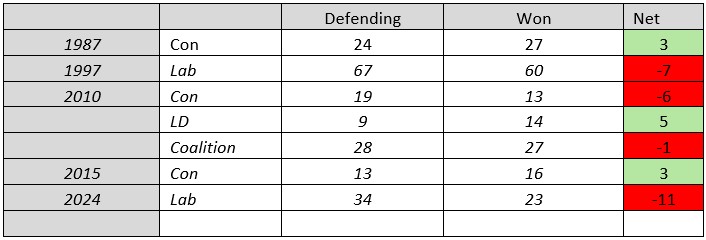
By election performance in the first year of a new government
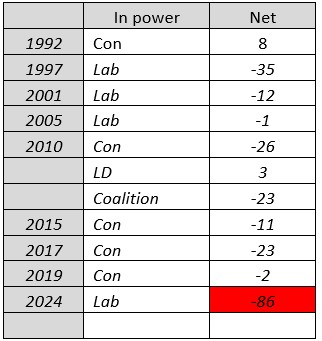
From the 1st May 2025, the pattern has been different, with Reform doing very well. They are gaining seats at a considerable rate, with us in second place.

After a several weeks with no wins at all (their driest period ever), the Conservatives have now won seats – including gains from Reform, us and the Greens. However, overall, their results remain poor. The official opposition, facing an unpopular government, have neve done so badly.
Labour’s results are a disaster. While a government expects to make losses, they are haemorrhaging councillors. Since the 1st May, Labour have ‘lost’ (by election losses and defections) 100 councillors – about one a day. The Conservatives are little better, down 97 (in percentage terms, this is even worse as they have fewer councillors – 2%).
This reflected in vote share changes:

On this measure, Reform, of course, do very well, as they are starting from rock bottom. We also gain vote share – the only other party to do so.
Another way to look at by election vote share is how much of our actual vote do we retain. By elections almost always have a lower turn-out, so while percentage vote share shows how well each party does relative to others it doesn’t show how well we are doing at getting our scheduled election voters out (this measure doesn’t work for Reform).
By Election Vote Share since 1 May 2025

The Liberal Democrats are also doing extremely well on two other metrics – converting second places to wins and holding seats.
Conversions of second place into By Election wins
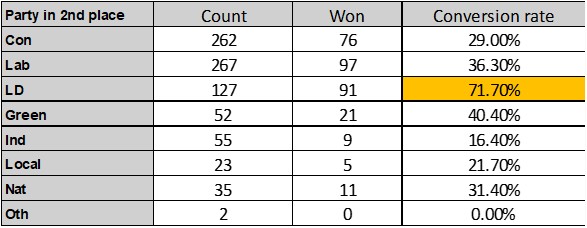
Reform don’t feature in the conversion chart as they don’t have previous second places to win from. The cumulative results show us topping the chart and continuing to win.
It is a noticeable feature of current by elections that, whilst Reform have a good base vote everywhere, the Liberal Democrats tend to either be competitive and in the top two, or down in the weeds. We have only been in third place twice – and in both we were a strong third. In essence, we have become a party with our vote strength geographically concentrated, an advantage under First Past The Post. It also reflects our style of campaigning.
Multi-party politics also means that seats can be won on very low votes. On 1st May, the Lib Dems won Truro Moresk & Trehaverne on Cornwall Council with 18.9% of the vote (with a 38% turnout that means that the winning candidate attracted votes from just 7.2% of the electorate). In a recent by election in Prestatyn Central, Denbighshire, a Conservative held the seat with 21.7% of the vote.
Taking a local at defences, the Liberal Democrats are performing very strongly and even more so since the 1st May. Historically our defence rate has been more like 66%, so this is a very good performance.
Reform have now held a defence – in Durham – but their track record of holding seats is very poor.
By Election seat changes since 1 May 2025
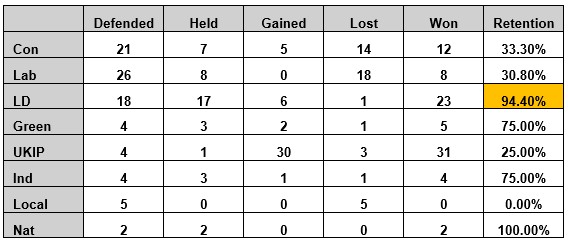
Both the Tories and Labour defence rates should be turning hair grey in their respective HQs.
In fights with Reform, the Lib Dems have done well (and better than anyone else). The chart below shows the ‘head to head’ fights, looking at each party against Reform (i.e. the first row is seats when Conservatives were in first or second place, with Reform taking the second position and so on).
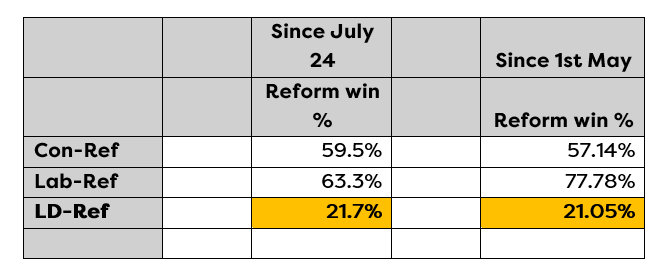
There were few Green – Reform ‘head to heads’, so it is not statistically valid to compare their ‘head to heads’.
We are holding a position of winning close to 80% against Reform. The Tories are on about 40%, while Labour are getting worse from winning a third to only a quarter since May.
This gives us a good argument that we are the party best able to tackle Reform in local elections. However, it is also clear that Reform is continuing their very strong performance from May:

Overall, by elections are more volatile than ever. There is a high rate of change, following on from the local elections in May. Where we put in a strong campaign, it has a high likelihood of being successful, even more so where we have existing activity. Of course, there is also a danger for our seats. Some previously reasonable comfortable seats, for instance where we win with 40-45% of the vote, may now become more competitive with even a modest drop in our vote.
There should be no by elections in which we fail to field a candidate. Even in seats we are far behind, with the right campaign and message we can make real progress, as we saw in Leeds Morley, where we started on less than 2% of the vote, and Sheffield, where we started in a weaker third place:
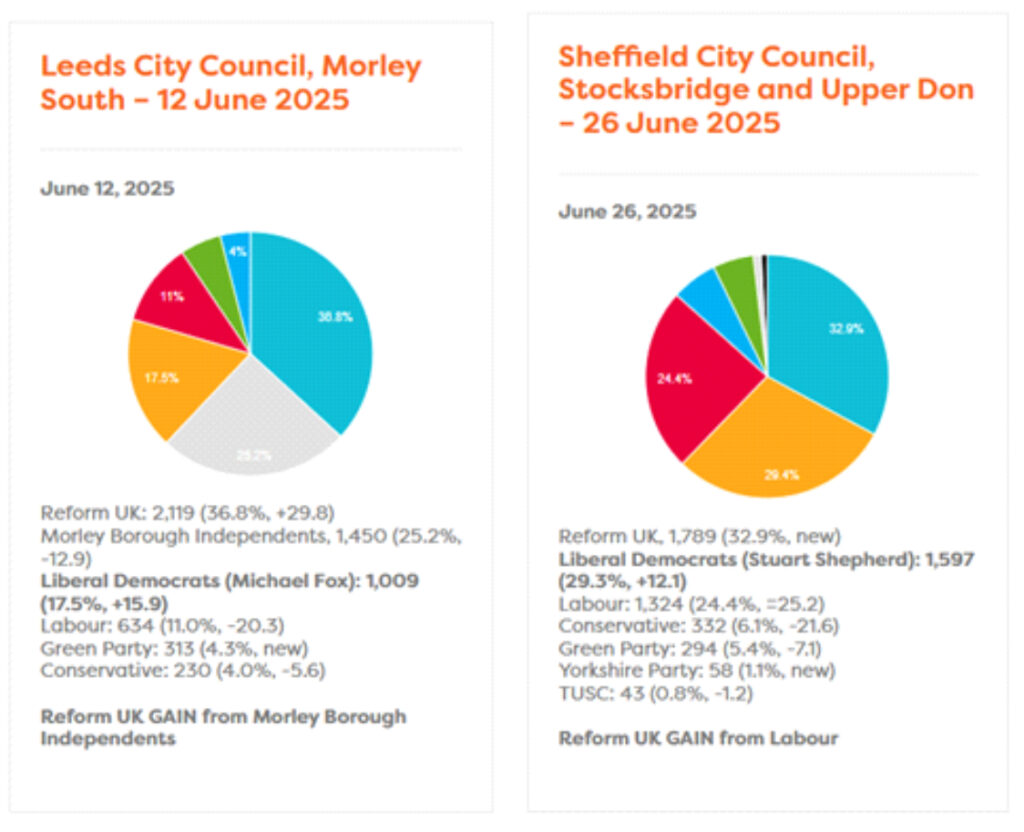
This article has been written by Richard Cole, Head of Development at ALDC. Thank you to John Swarbrick for invaluable help with the statistics and analysis.
says
I'm wondering where that second place to wins data comes from. Over 700 second places for various parties makes it look more like May 2025 than by elections. In by elections this would be interesting, especially at the extremes - just how far behind can we be and win?
Colin Peacock says
Been hoping that someone else would do this analysis. My County (Lancs) now has a Reform majority. Might they be competent "anyone but Tory and Labour" people? or Farage-cloned bigots? Being a real Liberal I await the results of their actions.